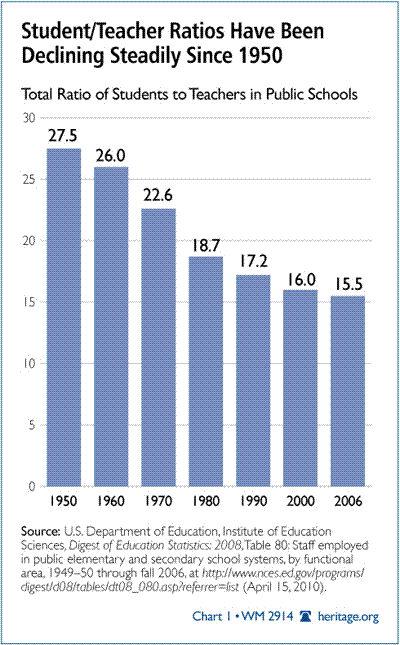Congress is considering $23 billion in new “emergency” spending on public education. This new spending comes on top of the nearly $100 billion appropriated to the Department of Education through the 2009 economic stimulus bill. At the same time, $34.7 billion in stimulus funds for education remain unspent.[1]
States should consider reforms that would reduce costs and more efficiently use existing funds. More federal funding is unlikely to increase student achievement and will not provide a long-term solution to states’ budget shortfalls. Another bailout from Washington could even exacerbate states’ fiscal problems by creating disincentives for states to tackle out-of-control spending and make the difficult budgetary decisions necessary to produce long-term, systemic education reforms.
Job Growth in Public Sector Education
Education Secretary Arne Duncan says more spending is necessary in order to prevent catastrophic layoffs and that school districts have already taken “detrimental” measures to cut education spending.[2] He warned that “millions” of children will be negatively affected if the $23 billion in additional federal funding is not approved.[3]
But for decades public school staffs have been increasing significantly at great expense to states’ budgets. While taxpayers have been on the hook for increasing public education staff rolls, smaller class sizes and increases in both teaching and non-teaching staff positions have failed to increase academic achievement for students.
Increases in Non-Teaching Staff Positions. Staff hires in the public education sector in recent years have outpaced student enrollment. Since 1970, student enrollment in public elementary and secondary schools has increased just 7 percent, while public elementary and secondary staff hires have increased 83 percent. Trends since the 1950s indicate that the number of teachers as a percentage of school staff has declined significantly. In 1950, more than 70 percent of elementary and secondary instructional staff was comprised of teachers; by 2006, teachers made up just slightly more than 51 percent of public school staff. Administrative support staff increased from 23.8 percent to 29.9 percent during that same time period.[4] In the mid-20th century, public schools employed 2.36 teachers for every non-teacher on their rolls; today, the ratio is closer to one to one.[5]
As a result of staggering staff increases in both teaching and non-teaching capacities, inflation-adjusted per pupil spending in public schools has increased from $2,065 to over $11,000 from 1950 to 2007.[6]

Growth in Staffing Far Outpacing Student Population. In addition to increases in non-teaching staff positions, more teachers are also now teaching fewer students. From the nine years spanning the 1997–98 school year to the 2006–07 school year, student enrollment in public schools increased 6.8 percent. Over the same time period, the number of teachers in the classroom increased 15.8 percent.[7]
Student-teacher ratios have been on the decline since the mid-20th century. In 1950 for example, there were 27.5 students for every one teacher; by 2006 that number had declined to 15.5 students for every public school teacher.[8] For high school students during the 2006-07 school year, the average student-teacher ratio was just 12:1.[9]
While public schools and districts throughout the country continue to reduce class size, there is little evidence that such reductions have improved student learning. For instance, Florida began implementing sweeping education reforms in 1998, including strong state standards, the transition to an “A–F” system for grading schools, ending “social promotion,” and alternative teacher certification.[10] These systemic education reforms appear to have had a positive impact on student achievement, particularly minority students. However, a 2002 reform to reduce class size found “no detectable benefit” of the class-size mandate and found that “monies restricted for the purpose of funding class-size reduction mandates are not a productive use of limited educational resources.”[11]
Education Spending Increases. From 1990 to 2006, total annual per-pupil education expenditures increased from $8,627 to $11,293.[12] Moreover, inflation-adjusted federal education spending and combined federal tax expenditures for K-12 education have increased 138 percent since 1985.[13] While education spending at every level has increased substantially over the past three decades, there has not been a commensurate increase in academic achievement. Since the 1970s, national reading scores have remained relatively flat, and high school graduation rates have hovered around 70 percent. Despite this, President Obama’s fiscal year 2011 budget increases federal education spending by 10 percent.[14]
Systemic Reform Needed
The Obama Administration’s plan to appropriate billions in additional federal funds to help states tackle education budget shortfalls will only discourage states from dealing with the root causes of skyrocketing education spending. States should instead consider cutting costs in areas that are long overdue for reform and pursue systemic reform to improve student achievement. Such a strategy would not only prevent already overburdened taxpayers from incurring more debt, but it would put states on a path toward meaningful education reform.
Lindsey M. Burke is a Policy Analyst in the Domestic Policy Studies Department at The Heritage Foundation.

